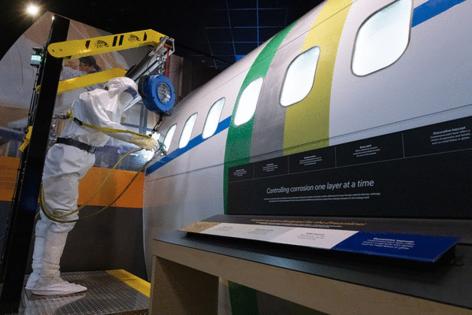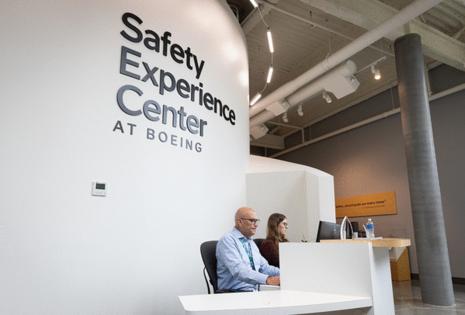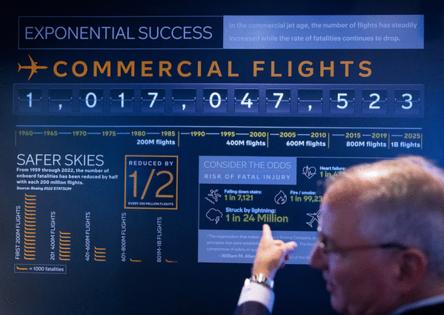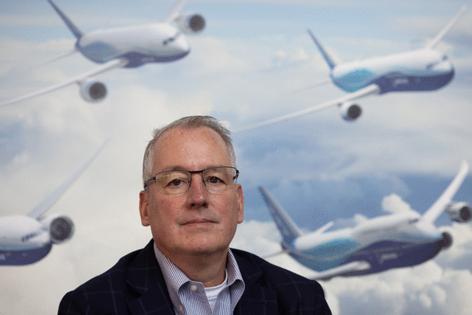Meet the Boeing engineer tasked with reviving the reputation for safety
Published in Business News
Don Ruhmann, Boeing’s chief aerospace safety officer, thinks the company is “poised” for change.
Ruhmann, 61, is the second person to take on the role since Boeing created it in 2021, in the wake of two deadly 737 Max crashes. His office is in charge of some of the company’s most-criticized programs, including an internal channel for employees to raise concerns and a system meant to identify safety risks before disasters occur.
Crucially, Ruhmann also manages a Federal Aviation Administration-supported program that allows Boeing employees to perform tasks on behalf of the regulator.
Last year, the Transportation Department's inspector general found those Boeing employees doing FAA work faced “undue pressure” to keep planes moving through the factory. Then, earlier this year, the National Transportation Safety Board found Boeing’s safety management system to identify risks was “inadequate” and lacked FAA oversight.
Boeing has since made changes to those programs and to its overall approach to safety, prompted by a panel blowing off an Alaska Airlines 737 Max in January 2024. It’s starting to see the fruits of those efforts as airline customers and regulators regain trust in the company.
Ruhmann, who moved into the chief safety role in March, expects Boeing will continue to see the impact of those efforts, as well as the effects of four years of changes it has implemented since setting up the chief aerospace safety office. Those big-picture changes are set to make their way to individual products, whether that's an airplane, a rocket, an instruction manual or a training course.
“That part's really exciting, to see everything they’ve already done and how poised they are to actually make a difference,” Ruhmann said in a September interview.
“I think we’re in a really good position to start seeing the connection to the actual product,” he continued. “It could be a number of different things, but we’re getting it to the people who own the products — so they can do something differently.”
Defining safety goals
Ruhmann, a 36-year Boeing veteran, spent most of his career on the commercial aircraft side, including as vice president of development programs for Boeing Commercial Airplanes, chief project engineer for the 787 and director of engineering for the 777 and 777X.
His office now has a broad mandate, with the 1,200-person team in charge of coordinating with regulators, assisting accident investigators, ensuring the safety of products and monitoring worker safety in the company’s sprawling factories.
Success can’t be easily pinned to one metric, Ruhmann said. A lot of it comes down to what you’re seeing and hearing from employees.
He pointed to one of the team’s main goals, instilling a “just” culture.
“What does it really mean to have a ‘just’ culture?” Ruhmann asked rhetorically. “When you talk about it, it’s like ‘OK, that makes a lot of sense.’ But practicing it every day — it’s not like designing a valve that opens and closes.”
“I’m an engineer,” Ruhmann continued. “I’m going to want a spreadsheet with all the answers, and I’m not going to get a spreadsheet with all the answers.”
Over the next five to 10 years, he hopes to focus on “safety resilience.
Right now, the industry largely studies what went wrong to prevent it from happening again. But, Ruhmann said, that leaves them with limited data. His team is focused on shifting to what went right and looking at what data they can collect to make sure things keep going smoothly.
“We’re never going to stop doing individual root-cause corrective action,” said Ruhmann, referring to the investigations triggered by accidents or concerning incidents. “We do that today, and we do it really well. An event happens, we understand it, we work it and we go make a change."
Now, he continued, we're "layering on top a safety-resilience concept, to try and prevent the next accident. It’s going to take a while to learn how to do it.”
He also plans to focus on improving Boeing’s Speak Up program, an internal channel where employees can report safety concerns. After the Alaska Airlines blowout, employees told investigators they did not trust Boeing’s internal channels. They feared they would be punished for speaking up or didn’t believe the company would fix an issue they had raised.
Ruhmann said he wants to turn Boeing’s Speak Up system into the “benchmark of the industry." Part of that requires the company to admit it didn’t get it right the first time, he said.
He wants people to come to Boeing and say, “It took you a while to figure that out, it took you a while to talk about transparency, it took you a while to build trust with your employees, but … we worked our way through all those difficulties. We had hard conversations, and the Speak Up system is trusted and used by all of our employees.”
Identifying risks
Ruhmann’s team is also responsible for setting up the Safety Management System, or SMS.
The system is meant to help aerospace manufacturers and commercial airlines manage safety risks by creating a structured approach to identifying hazards. Last year, the FAA mandated aerospace design and manufacturing organizations, including Boeing, must have an SMS in place by May 2027.
Boeing has had a voluntary SMS since FAA approval in 2020. But last year, a panel of experts convened by the FAA determined that front-line employees didn’t understand their role in the system. After investigating the Alaska Airlines panel blowout, the NTSB said in June that Boeing’s SMS was “inadequate, lacked formal FAA oversight and did not proactively identify and mitigate risks.”
Ruhmann said the panel blowout pushed Boeing to “accelerate SMS thinking” across the company.
To prepare for the mandatory deadline, Boeing has to add three elements, Ruhmann said: an organization description, a summary of employee feedback from Boeing’s Speak Up channel and a two-way system for reporting hazards with airline customers and suppliers.
Boeing submitted the first two elements for FAA approval in June and expects to submit the third this month. The whole experience, Ruhmann said, is like “turning in your homework."
Once in place, Boeing and the FAA will monitor that the system is working as it’s meant to. Long term, Ruhmann hopes it will help Boeing ensure the culture change it wants to execute has a lasting impact.
Working with regulators
In a sign of renewed confidence, the FAA recently restored Boeing’s ability to self-certify the airworthiness of some 737 Max and 787 planes coming off the production line. The regulator revoked that authority for the 737 in 2019, after the deadly Max crashes, and for the 787 in 2022, because of production quality issues.
The decision seems like a turning point in how the FAA views Boeing, but Ruhmann said it won’t change much.
He recently participated in walk-throughs to certify the airworthiness of a 737 Max in Renton, Washington, and a 787 in Charleston, South Carolina. In both cases, Boeing and FAA employees inspected the airframe together.
"We have inspectors that are prepared," Ruhmann said. It’s not a big leap or change in work because they do it together anyway.”
Asked about his involvement with the FAA’s decision, Ruhmann said there wasn’t one big meeting where Boeing proved the company was ready to take on this authority. Instead, it was the result of the FAA’s continued participation in weekly meetings and daily walk-throughs, and lots of data.
“This is a journey they’re on with us,” Ruhmann said. “That showing of readiness and preparedness happens all the time.”
In Boeing’s most recent annual safety report, Ruhmann’s office found the amount of “perceived interference” among Boeing employees completing tasks on behalf of the FAA had declined over the last three years. But, in 2024, 9% of the unit’s roughly 1,000 members still said they perceived interference in their roles.
Ruhmann said that’s something his office needs to address, “whether it's substantiated or not.”
“It doesn’t only come from being explicit in writing down what interference is,” Ruhmann said. “You need to have the value. You need to own the value. You need to behave properly.”
Ruhmann said Boeing has always had a good relationship with its regulators. He recently hosted the director of Europe’s aviation safety agency for a tour of Boeing’s Renton and Everett factories, and his team works with the FAA as part of its daily routine.
“From where I sit, the tone is the same,” Ruhmann said. “Safety, you can’t compromise it. Certifying and confirming a product that we built and deliver, it's not up for negotiation. There’s not really a tone change around the mission of those two things.”
©2025 The Seattle Times. Visit seattletimes.com. Distributed by Tribune Content Agency, LLC.



















Comments